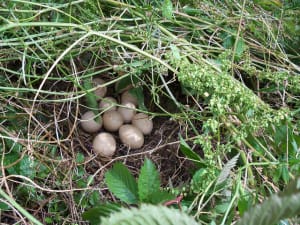[This action alert has been completed. The comment period is now closed.]
Comments Due by February 27, 2015
 |
Long held principles of organic farming commonly articulate values and goals that link organic farms with protection of biodiversity. “Organic production” is defined in federal regulations as a “production system that is managed to respond to site-specific conditions by integrating cultural, biological and mechanical practices that foster cycling of resources, promote ecological balance, and conserve biodiversity.” [Emphasis added.]
Over the years, the National Organic Standards Board has issued guidance statements and has urged the USDA’s National Organic Program to strengthen biodiversity conservation by issuing formal, enforceable guidance. (Adapted from “Implementation of Biodiversity Conservation in Organic Agriculture Systems, NOSB March 5, 2009.)
The National Organic Program has now issued a Guidance that applies to all phases of the organic system, including both the production and handling/processing of organic food. This proposed Guidance to conserve biodiversity is a significant step forward, but needs further strengthening. Please show your support for the following key points.
Click here to submit your electronic comments by February 27.
- Recommend that natural ecosystems should not be converted into organic production.
The Organic Food Production Act of 1990 prohibits the organic certification of any land upon which prohibited substances (most synthetic agrichemicals) were applied during the three previous years. This important provision is not in question, but it has created an unintended incentive to convert natural, undisturbed ecosystems (land that has not been previously conventionally farmed), that would not need the three-year waiting period.
The International Federation of Organic Movements (IFOM) states that “clearing or destruction of High Conservation Value Areas is prohibited. Farming areas installed on land that that has been obtained by clearing of HCV areas in the preceding 5 years shall not be compliant with this standard.”
We strongly recommend strengthening this guidance document by adding that any natural ecosystems converted to organic not be eligible for consideration for organic certification for five years.
- Recommend that operators of CRP lands (Conservation Reserve Program) leaving the federal program and now requesting organic certification must consider the best agricultural use alternatives and have a comprehensive conservation plan.
For many years, highly erodible lands were frequently placed into the federal Conservation Reserve Program (a cost share and rental program administered by USDA). The CRP lands were taken out of crop production to protect fragile, erodible soils. Many CRP lands have been in the program for years and now possess vibrant plant cover that provides watershed protection and wildlife habitat.
However, tens of thousands of acres are being removed from the CRP program over the next few years. Without special consideration, it is possible that organic certification may incentivize reducing, rather than improving, conservation. Since all CRP parcels were initially enrolled because of conservation and soil concerns, operators should recognize that the best use may not be plowing land for organic production. Operators should instead examine a range of alternatives (which might include keeping the land in permanent cover as pasture).
We recommend that to be eligible for organic certification, a comprehensive conservation plan must be developed and implemented for any CRP lands proposed for organic use.
- Recommend that the Guidance include organic certifiers, organic operations and applicants for certification.
The proposed Guidance, as written, applies only to certified operations. It should also apply to organic certifiers and new applicants for organic certification.
- Recommend that the Guidance’s “Background” section be modified to incorporate biodiversity into the evaluation process used by the USDA for accreditation of organic certifiers and the USDA’s audit of accredited organic certifiers.
This strengthens the oversight protocol requiring the USDA to assure the certifiers are enforcing the spirit of the law in regards to protecting biodiversity and the environment. The lack of these procedures, as applied to accredited organic certifiers, has hampered the overall progress and goal of conserving biodiversity and natural resources.
- Express support for including both handling and processing of organic foods as part of the new Guidance.
Should you wish to mail comments, send them to:
Stacy Jones King
Agricultural Marketing Specialist
National Organic Program, USDA–AMS–NOP,
1400 Independence Ave SW., Room 2646—So., Ag Stop 0268
Washington, DC 20250–0268
As part of your mailing, be sure to put “Document Number AMS–NOP–14–0062; NOP–14–01” on the envelope and in the text of your mailing.
These comments, from the Wild Farm Alliance and their partners, provide additional useful background information and other recommendations.

